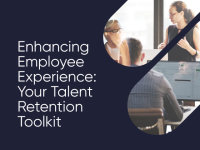CallMiner Product Innovation Series: Q1 2025
CallMiner's, Bruce McMahon, shares key product updates from Q1 2025. CallMiner AI Assist advancements, CallMiner Outreach, Bulk Export API enhancement...
CallMiner Outreach is here! |Learn about the future of CX

Solutions
Products
Customers
Solutions
Products
Customers
Resources
Company
The Team at CallMiner
June 03, 2019


Today’s contact centers are all too familiar with agent turnover. The industry’s employee turnover rates remain more than double the average for all other U.S. occupations, with large call centers reaching over 50%. Not only does this come at an expensive cost to companies due to the time and resources it takes to hire and train, but it can also lead to bad customer experiences—an indirect attack against the heart of your brand. That’s because even before these employees decide to pull the plug, their lack of engagement leads to reduced sales, subpar customer service, and more.

So, what’s leading to this growing problem? Let’s run through some of the triggers that send employees running in the other direction and how managers can help stop the cycle:
The problem: Research shows that less than 21% of employees believe their employer has implemented a fair evaluation process. This holds especially true for call center agents who interact with thousands of customers per month, but only receive feedback on < 5% of these conversations. This approach only offers a mere glimpse of the employee’s actual performance and often empowers opinionated reviews – not to mention the feedback is often focused on what could be improved. With only one in three workers receiving positive recognition on a weekly basis, managers are inadvertently opening the door for them to leave.
The solution: No employee should ever have to guess where they stand in terms of performance—and they shouldn’t have to wait to hear it, either. Speech analytics technology leaves no room for guessing. By analyzing 100% of phone calls in real-time, it allows agents to pinpoint exactly where they can improve, but also sheds light on the areas they’re excelling in. It also removes the potential for any internal bias, offering both agents and managers the peace-of-mind they need to ensure they’re holding each other accountable.
The problem: Agents are at the frontline when it comes to customer experience – and so their performance plays a huge factor in company metrics. Everything from average handle time (AHT) to net promoter score (NPS) is fueled by their interactions with the customer. But when they’re left in the dark over best practices, product information, company updates and more, they’re unable to accurately portray themselves as a brand expert. These situations put your employees at a high risk to not correctly solve a customer inquiry—something that simply can’t be resolved with a script.
The solution: Your organization is likely constantly evolving, which means the contact center needs to keep up. Companies tend to struggle with this, as they fail to offer continual education programs or provide support to those that need an extra push. Not only should the training process differ between organizations, it should also be modified to fit each agent’s unique needs. Instead of turning to legacy training methods, speech analytics can offer each employee a personalized training program based on actionable insight from their calls and modifiable alerts in accordance with business initiatives.
The problem: While most companies believe they set their employees up for success, an astonishing 84% of agents would disagree. With a lack of resources deemed the primary stress indicator in the workplace, there’s no reason employers should compromise when it comes to internal resources. How can you expect an agent to properly resolve your customer’s problem in a timely manner when they’re required to juggle multiple applications before they can even pinpoint the issue?
The solution: You guessed it, speech analytics. The technology works to combine what’s going on in real time with historical data for context to guide your agent to the proper solution. It identifies words, phrases, and even considers acoustics to allow your agent to offer the appropriate action based on the customer’s behavior. Depending on your organization’s preferences, this can then prompt your agent to make a specific offer, upsell where applicable, redirect the call, and more.
When it comes to employee nurturement, investing in the right technology pays off. Speech analytics is a proven solution to increase revenue and improve the workplace environment by encouraging agents to make clear, value-driven decisions themselves. In the end, this not only converts employees into brand advocates, but also drives performance across every level of the business.
I encourage you to learn more about best practices in coaching your agents to success.
CallMiner is the global leader in AI-powered conversation intelligence to improve customer experience (CX). CallMiner delivers the industry’s most comprehensive platform to analyze omnichannel customer interactions at scale, combining deep domain expertise with cutting edge AI analytics and machine learning. By uncovering better intelligence, CallMiner enables companies to identify areas of opportunity to drive better experiences, ultimately leading to business improvement, growth and transformational change. CallMiner is trusted by the world’s leading organizations across all major verticals including technology, media and telecom (TMT), retail, manufacturing, financial services, healthcare, and travel and hospitality.